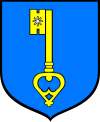Stopnica
| Stopnica | ||
|---|---|---|
| Town | ||
|
Saints Peter and Paul Church in Stopnica | ||
| ||
 Stopnica | ||
| Coordinates: 50°26′21″N 20°56′26″E / 50.43917°N 20.94056°E | ||
| Country |
| |
| Voivodeship | Świętokrzyskie | |
| County | Busko | |
| Gmina | Stopnica | |
| Population | 1,545 | |
Stopnica [stɔpˈnit͡sa] is a town in Busko County, Świętokrzyskie Voivodeship, in south-central Poland. It is the seat of the gmina (administrative district) called Gmina Stopnica. It lies in Lesser Poland, approximately 17 kilometres (11 mi) east of Busko-Zdrój and 55 km (34 mi) south-east of the regional capital Kielce.[1] In 2007 the village had an approximate population of 1,500. In 1362 Stopnica was granted the civic rights by King Casimir III the Great. Stopnica lost the rights in 1870 and regained in 2015. During World War II the village was almost completely destroyed. Before the war Stopnica had a large Jewish community, which perished in the Holocaust.
Location and name
In the Middle Ages, Stopnica used to be one of major urban centers of Lesser Poland’s Sandomierz Voivodeship. The village is located 15 kilometers east of Busko-Zdrój, on the Stopniczanka river, along National Road nr. 73. Stopnica is a road hub, where the road nr. 73 crosses with local roads 756 and 757. The name of the town most probably comes from early Slavic word stob, which was associated with settlements located near marshes, lakes and rivers. Unlike the contemporary town, early Stopnica was not located on a hill, but in the valley of the Stopniczanka, among marshes and ponds.
History
First mention of Stopnica (known then as Stobnica) comes from the 12th century, but a gord, or Slavic settlement, had existed here earlier. According to Jan Długosz’s chronicle Annales seu cronici incliti regni Poloniae, in 1103 the parish priest of Stopnica, reverend Baldwin, became the Bishop of Kraków. In 1362 Stopnica was granted the civic rights by King Casimir III the Great. On King’s order, a castle, a hospital and a Gothic church were built here. In 1498, King John I Albert confirmed the status of Stopnica. At that time, it was the seat of a starosta, and the town enjoyed several privileges, granted to it by the kings of the Jagiellon dynasty (1410, 1439, 1442, 1444, 1445, 1487, 1520). In 1470 professor of Jagiellonian University Jan of Stobnica was born here.
Together with several other locations in Lesser Poland, Stopnica in the 16th century was one of the centers of the Protestant Reformation. A Calvinist church was founded here in 1551 by Marcin Zborowski, an influential nobleman, voivode of Kalisz. In 1649 King John II Casimir confirmed the town status of Stopnica, and banned Jews from settling in the market square and around the parish church. Stopnica maintained its position of an important urban center of Sandomierz Voivodeship, but the town declined in the 1650s, during the Swedish invasion of Poland. Firstly, it was looted and burned by the Swedes, then more destruction was brought by the Transilvanian troops of George II Rakoczi. To make matters worse, in 1662 a plague decimated the population. After the complete destruction, Stopnica never recovered. In 1787, the town was visited by King Stanisław II Augustus, and on April 10, 1795, Stopnica almost completely burned. After the Partitions of Poland, Stopnica was annexed by the Austrian Empire, but in 1809 it became the seat of a county of the Duchy of Warsaw (in 1815 the Duchy was turned into the Russian-controlled Congress Kingdom). Residents of Stopnica County actively supported the January Uprising (1863), forming a regiment of infantry. As a punishment, the Russians reduced Stopnica to the status of a village, which nevertheless remained the seat of the county until 1915, when the Austrians replaced it with Busko-Zdrój.
During World War II, Stopnica was completely destroyed, first partially in September 1939 and later completely in the summer and autumn of 1944 when the Wehrmacht tried to halt the advancing Red Army. After the war, not a single house remained in the village. The Germans organised here a ghetto, the inhabitants of which were later murderd in Treblinka extermination camp.
Points of interest

- Gothic St. Peter and Paul church,
- complex of a monastery,
- royal castle, built by King Kazimierz Wielki in 1350. Rebuilt in Baroque style in 1661, then rebuilt again in 1783, it seated local authorities of the Stopnica County in the 19th century. The castle partially burned in 1859, and was completely destroyed in World War II. Now the castle is under construction.
See also
External links
![]() Media related to Stopnica at Wikimedia Commons
Media related to Stopnica at Wikimedia Commons
Coordinates: 50°26′21″N 20°56′26″E / 50.43917°N 20.94056°E

